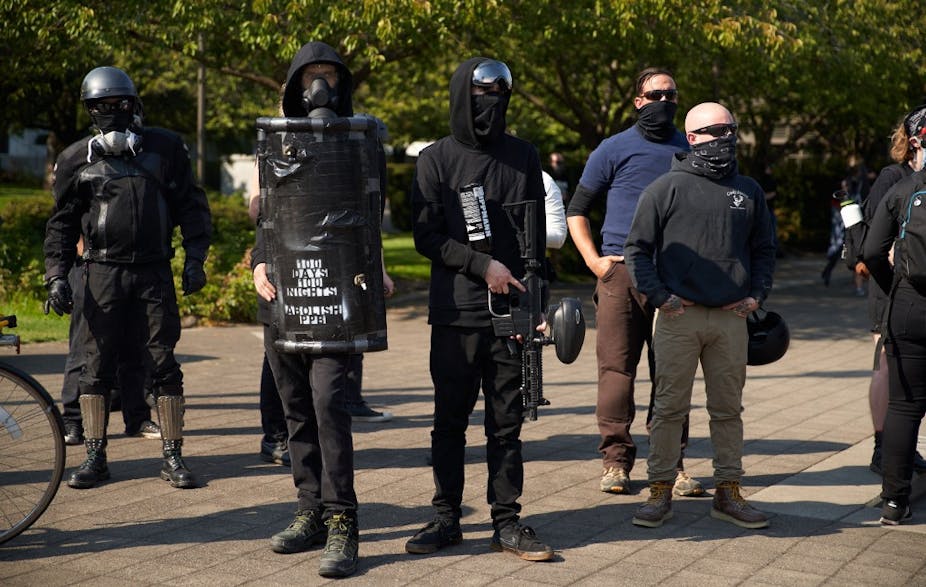Ever since the antiracism protests that followed the May 25 death of George Floyd at the hands of Minneapolis police officers, President Donald Trump has repeatedly asserted that that Antifa (short for “antifascist”) groups threaten American democracy. On September 30, he once again called them (in his usual style) “a very bad group”, which he says should be considered a “terrorist organization”.

The origins of the antifascist movement
The term refers more to an amorphous movement than an association, a flexible network of activists who share a general philosophy, sometimes try to coordinate their activities, but generally operate spontaneously, responding to events at a highly local level. There’s no hierarchy, official status or precise system of organization.
Local groups are independent and do not announce their actions ahead of time. The number of members varies, increasing or decreasing depending on the circumstances. Sometimes they can work with loosely structured organizations such as Black Lives Matter, other times they work by themselves. Their sometimes violent actions have been rejected by many protest organizers working for causes that Antifa groups care about – authoritarianism and antifascism, racism, homophobia and xenophobia, for example.
All this means that it is difficult to establish the exact genealogy of the Antifa movement. The oldest group in operation, Rose City Antifa, was created in Portland, Oregon, in 2007, with the aim of shutting down a neo-Nazi music festival. While Trump singled out the Antifa movement after his election, they gained prominence after the tragic events in Charlottesville, Virginia, on August 11, 2017. That day a rally by white supremacists and neo-Nazis also attracted counter-protestors, including Antifa activists. They were demonstrating peacefully when James Alex Fields Jr., a white supremacist, drove his car into the crowd, killing one person and injuring more than a dozen others.
Fields’s actions were deemed a terrorist attack and he currently in prison serving two life sentences without the possibility of parole. In response to the deadly violence perpetrated by Fields, Trump claimed that there were “very fine people on both sides” and in the first presidential debate refused to condemn violent right-wing groups. His remarks were widely criticized.
Are they really a threat?
At least one death has been attributed to a person affiliated wth the Antifa movement. On August 29, a member of the far-right group “Patriot Prayer” who was part of a pro-Trump caravan in Portland, Oregon, died after being shot. The man accused of the killing, Michael Reinoehl, was shot by US marshals five days later. Overall, however, data show that Antifa activists have been involved in relatively few violent incidents compared to white supremacists, who have conducted at least 40 lethal attacks since 2018 according to the Department of Homeland Security.
Despite this, Trump and his attorney general, William Barr, have accused the Antifa movement of being the main instigators of violence, looting and public unrest. This is what serves as justification for the administration’s labeling them as “a domestic terrorist group”.
For both legal and political reasons, such accusations are immediately met with scepticism and criticism. Because the United States has no domestic terror law – something opposed by both progressive and conservative public officials – the only possibility would be to place the Antifa movement on the list of “foreign terrorist organizations”, something that has no basis in fact. The alternative would be take thousands of activists to court, thus criminalizing political beliefs and violating fundamental rights guaranteed by the US Constitution.
A polarized country
So does the Antifa movement represent a real threat to American democracy? Let us look more broadly at the partisan, political conflict that is being felt across the country. The Antifa movement is part of a polarization of political views that is eroding one the foundations of the American republic, the mutual recognition of the legitimacy of both political sides.
The groups against which the Antifa movement positions itself, including white supremacists, neo-fascists and right-wing nationalists, have been involved in numerous violent actions and killings. However, the Antifa movement’s own actions can contribute to the legitimization of violence, escalate conflicts rather than defuse them, and expose peaceful protesters to danger.
Calls for violence, whatever the source, can also be used by right-wing extremists to justify their own actions. There have even been cases of white nationalists infiltrating Antifa ranks to act as provocateurs in order to incite violence.
One variable in a complex equation
While Antifa activists can help create an environment that encourages this violence, they rarely plan and even more rarely control the violence that sometimes breaks out at protests – a fact that even the FBI has recognized. They are just one variable in a context that is ripe for sometimes violent interactions between opposing groups.
In an October 9 report, the Department of Homeland Security called the white-supremacist movement the “most persistent and lethal threat in the homeland”. By comparison, the Antifa movement has no structure or centralized hierarchy and thus it does not constitute a threat to American democracy, much less the United States.
Translated from the French by Rosie Marsland for Fast ForWord and Leighton Walter Kille of The Conversation France.
The Fact check US section received support from Craig Newmark Philanthropies, an American foundation fighting against disinformation.


